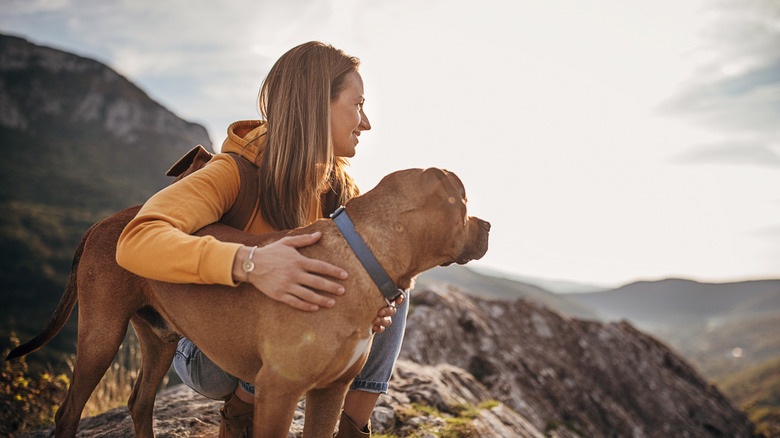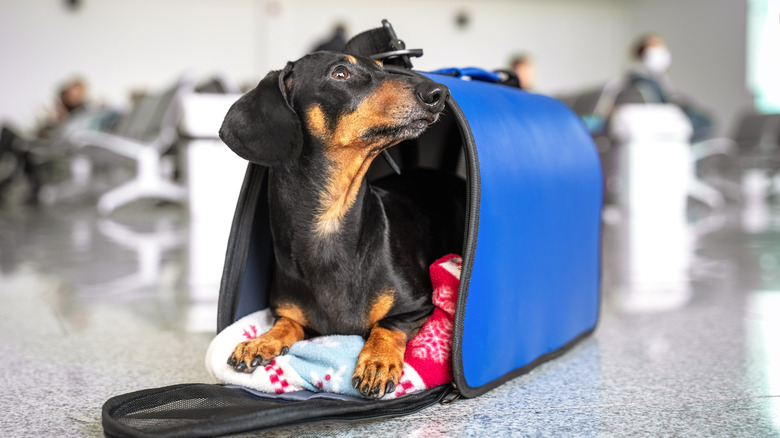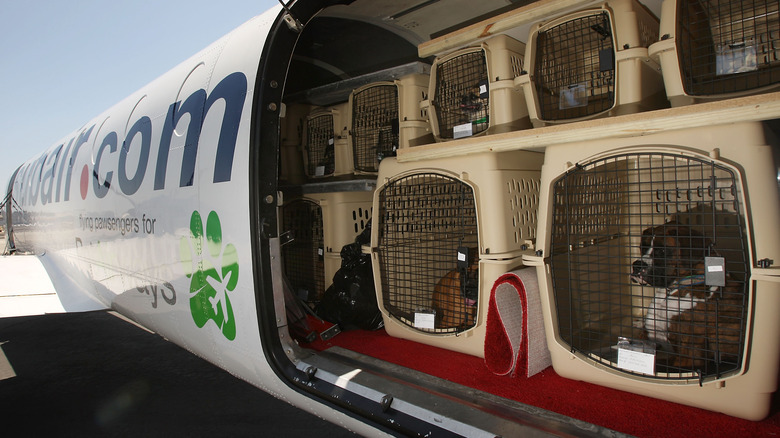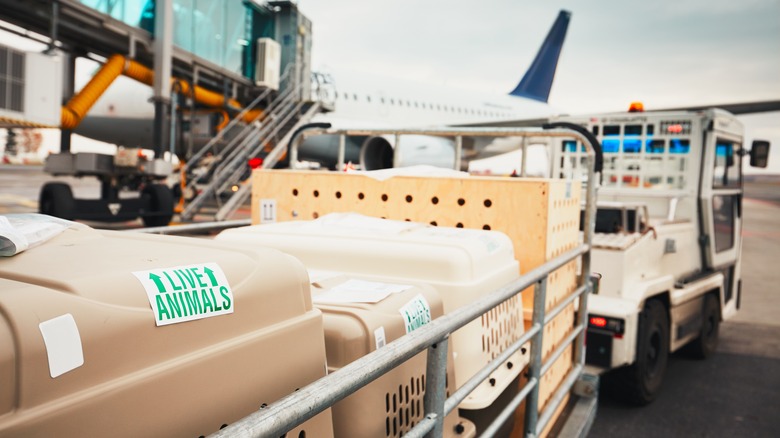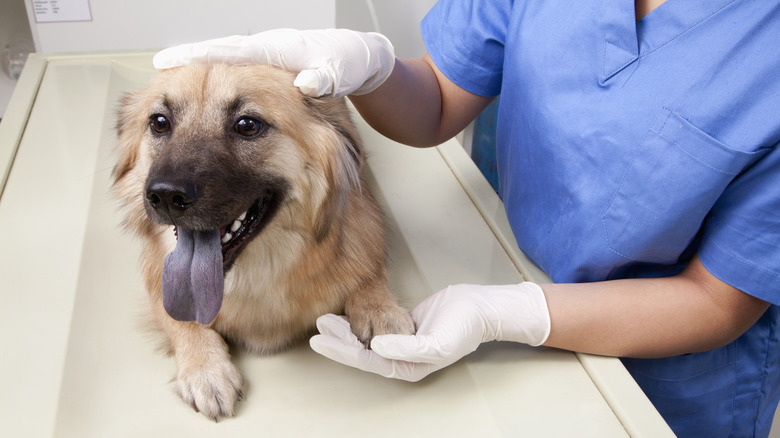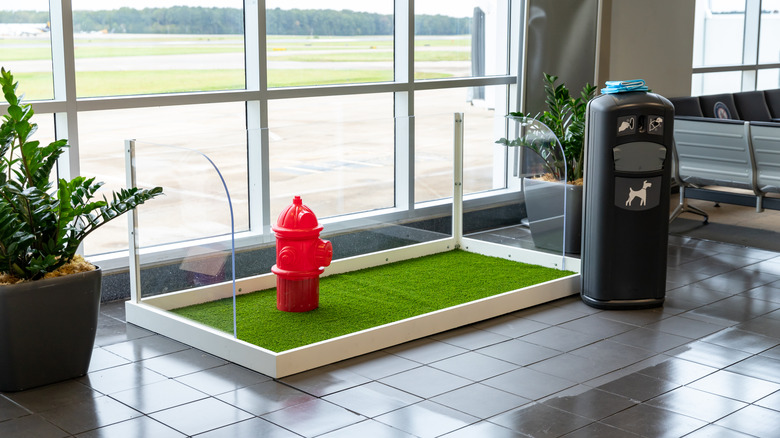What To Know About Traveling Internationally With Your Pets
Traveling internationally with your pet can be a great experience. For one, most of us consider our pets family, so exploring the world or vacationing with our quadrupedal companion can be an exciting proposition. But in some circumstances, it may be difficult — if not impossible — to travel internationally without your pet. Boarding costs and pet-sitting fees can be astronomical, and without calling in favors from family or friends, you may not be in a situation to leave your pet stateside for an extended period of time.
Knowing how to travel with a dog internationally (or cat) wisely can be the difference between a rewarding experience and a hassle-plagued trip. Taking your pet requires forethought, in-depth research, and savvy trip planning. While the idea of traveling with your furry confidant may be appealing, it's also a big responsibility with its own unique considerations, probably dictating what airlines you take, where you plan to stay, and the experiences you'll have.
That said, the reward of sharing your travels with your pet can make the effort, expenses, and sacrifices well worth it. But to avoid major problems, you'll need to be well-acquainted with everything traveling internationally with your pet entails.
Finding a pet-friendly flight
To begin planning your international adventure, it's imperative to research the various pet policies across different airlines. Most major airlines allow small dogs and cats to fly in the cabin with you, as long as they're placed in an FAA-approved pet carrier that fits comfortably under the seat. If you're the pet parent of a small dog or cat, you'll still need to check your flight before purchasing a ticket. Typically, airlines only allow a certain amount of pets on a flight, so you need to ensure a spot's available for your pet before purchasing your own ticket.
If your dog isn't small enough to fit under the seat in front of you, things get a bit more complicated. The only U.S.-based carriers that allow dogs to fly in the cargo hold are Alaska Airlines, American Airlines, and Hawaiian. Fortunately, international airlines tend to be a bit more accommodating. Air France, Swiss, Turkish Airlines, Lufthansa, TAP, SAS, British Airways, Alitalia, KLM, and Japan Airlines all currently allow larger pets to fly in cargo.
Pet policies and alternative transport options
It's important to note that some, but not all, airlines also have breed restrictions for the dogs they allow to fly in the cargo hold. These restrictions are typically imposed on short-nosed breeds, such as boxers, bulldogs, Boston terriers, and others, as these Brachycephalic breeds are prone to breathing difficulties. Overall, it's a good idea to contact the airline directly concerning any questions regarding breed restrictions.
If you're unable to find a flight that can accommodate you and your pet, whether due to breed restrictions or other factors, there's still hope. You may have the option to ship your pet through a commercial transport company, but you'll need to ensure the company is part of the International Pet and Animal Transportation Association (IPATA), a regulated organization that adheres to ethical safety standards.
If you are trying to travel with your pug or bulldog, IPATA works with airlines and transport companies that may accommodate your pet. IPATA created a Brachycephalic Certification Program that allows these types of breeds to fly after passing a fit-to-fly assessment. These specialized assessments can be conducted by a certified veterinarian, and the results are given to the airlines and companies partnering with IPATA, helping to ensure the safety of your dog.
The cost of flying with your pet
Airline pet fees aren't cheap. If your pet is small enough to fly in the cabin, the fees can be up to a few hundred dollars one-way, but these prices increase dramatically if the pet is traveling in the cargo hold. The cost will depend on the airline, the route (with or without layovers), and the size of the crate.
In most cases, when traveling with a pet, it's wise to spend up for a direct flight versus trying to save with layovers if your pet is in the cargo hold. But if your itinerary must include a layover or multiple, many airlines require a three-hour minimum time window between your connecting flights. This gives the airline ample time to feed, give water, and walk your dog to use the bathroom, but fair warning, these services aren't cheap. It's always a good idea to check with the airline to learn more about their specific policies.
If a direct flight isn't possible, then try to at least stick to the same airline. In simplest terms, changing airlines in a foreign country will require you to claim your dog from cargo, then pay another pet fee to the new airline. You'll also need to clear your dog through customs.
Paperwork and health assessments
Before you depart, you'll need to make sure your pet's paperwork is in order. While countries differ in their requirements, most require the following at minimum. First, you'll need to take your pet to a veterinarian to receive an international health certificate no more than 10 days before departure (or entry to the foreign country). You'll also need proof of a rabies vaccination taken within the last year for most destinations, as well as governmental export paperwork.
In addition, some countries require blood titer tests for rabies and proof of parasite prevention treatments. You need to research the requirements carefully of the particular country to ensure you have the proper paperwork, as the requirements are not flexible. Your pet will also require an ISO-compliant microchip, which is the world standard. If you need to update your pet's vaccinations, many countries require that the microchip be implanted before the pet receives its vaccinations. Finally, while most countries do not require a quarantine period upon entry, some rabies-free and island nations do, such as Australia, Japan, Hong Kong, and Iceland. The length of quarantine varies by country.
Prepping your pet for flight
Along with knowing how to travel with a dog internationally in financial and regulatory terms, it's equally as important to prepare your pet for the trip, especially if it's a long-haul flight. For instance, if your pet isn't used to being in a crate, then it's a good idea to acquaint your pet with one for a few weeks before the flight. This could mean requiring them to sleep in a crate or leaving them in one for periods of time.
Same idea with puppy pads. Whether they're flying in the cabin or the cargo hold, your fur buddy will probably be expected to use a pet relief area at some point. Flying can be a stressful experience for a pet, but introducing them to a crate and pads beforehand may help the situation.
While traveling internationally with a pet can be costly and time-consuming, it can also be an extremely rewarding experience after the rigmarole, as long as you plan carefully and know what to expect.
